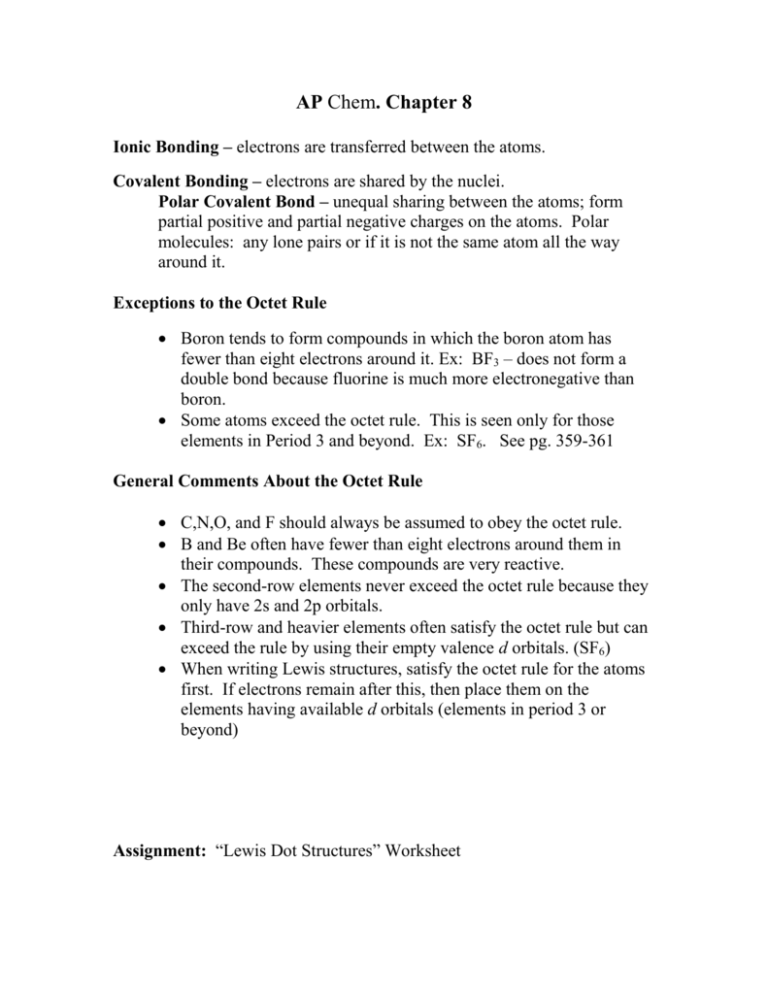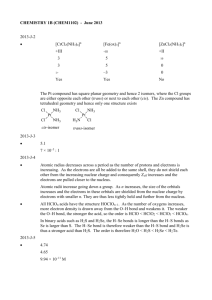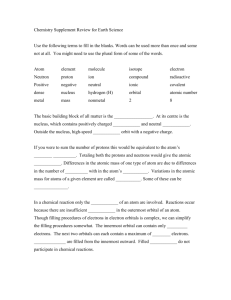Rules for Writing Lewis Dot Structures for Covalent Compounds
advertisement

AP Chem. Chapter 8 Ionic Bonding – electrons are transferred between the atoms. Covalent Bonding – electrons are shared by the nuclei. Polar Covalent Bond – unequal sharing between the atoms; form partial positive and partial negative charges on the atoms. Polar molecules: any lone pairs or if it is not the same atom all the way around it. Exceptions to the Octet Rule Boron tends to form compounds in which the boron atom has fewer than eight electrons around it. Ex: BF3 – does not form a double bond because fluorine is much more electronegative than boron. Some atoms exceed the octet rule. This is seen only for those elements in Period 3 and beyond. Ex: SF6. See pg. 359-361 General Comments About the Octet Rule C,N,O, and F should always be assumed to obey the octet rule. B and Be often have fewer than eight electrons around them in their compounds. These compounds are very reactive. The second-row elements never exceed the octet rule because they only have 2s and 2p orbitals. Third-row and heavier elements often satisfy the octet rule but can exceed the rule by using their empty valence d orbitals. (SF6) When writing Lewis structures, satisfy the octet rule for the atoms first. If electrons remain after this, then place them on the elements having available d orbitals (elements in period 3 or beyond) Assignment: “Lewis Dot Structures” Worksheet Warm up The chemical process of rusting involves the synthesis reaction of 84.0g of iron (III) and 48.0g of oxygen. What is the maximum amount of rust that can be produced? How much excess reactant is left over? Geometry Prediction Chart X = central atom Electron pairs Atoms bonded # of lone pairs to X on X Geometry Bond Angle around X 4 4 4 3 4 3 2 3 0 1 2 0 tetrahedron pyramidal bent triangular planar 109o 109o 109o 120o 3 2 1 bent 120o 2 2 0 linear 180o 6 6 6 5 0 1 6 4 2 5 5 0 5 4 5 3 2 octahedron square pyramidal square planar triangular bipyramid distorted tetrahedron T-shaped 5 2 3 linear 1 If only two atoms bonded together it will always be linear 180o 90o (SF6) 90o (ClF5) 90o (XeF4) 90o & 120o (PF5) 90o & 120o (SF4) 90o & 120o (ClF3) 90o & 120o (XeF2) Rules for Writing Lewis Dot Structures for Covalent Compounds 1. Count Valence electrons 2. Place least electronegative element in center 3. Give each atom 8 electrons except for hydrogen (only give hydrogen 2 electrons). Hydrogen cannot go between 2 atoms, only around outside. 4. Compare number of dots with total valence electrons. Same number of dots and valence electrons indicates all single bonds. Two dots too many indicates one double bond. Four dots too many indicates 2 double bonds or one triple bond. * Structural formula - draw one line to represent shared electrons 5. All carbon atoms must be bonded to each other 6. In acids with oxygen, hydrogen is bonded to the oxygen AP Chem. Lewis Dot Structure Worksheet Write Lewis Dot Structures and structural formulas, geometry, bond angle, and polarity for the following compounds: 1. SO2 18. H2O2 2. CO3-2 19. C2H6 3. NH3 20. CH3OH 4. CH4 21. C2H4 5. H2 22. C4H10 6. HF 23. C2H5OH 7. H2O 24. ClO- 8. N2 25. H2S2 9. HCl 26. HNO3 10.H2S 27. H2SO4 11.PF3 28. CH3NO2 12.CH3COOH 29. C2H2 13.NH4+ 30. ClO2- 14.NO2- 31. PO4-3 15.SO4-2 32. CO 16.NO2+ 33. CO2 17.HO- AP Chem. Chapter 8 (cont.) Resonance – occurs when more than one valid Lewis structure can be written for a particular molecule. The resulting electron structure of the molecule is given by the average of these resonance structures. Example: NO3- NO2- Formal Charge Sometimes it is possible to have several different Lewis Dot structures. It is necessary to estimate the charge on each atom in the various possible structures to decide which structure(s) is/are the best choice. Formal charge – the difference between the number of valence electrons on the free atom and the number of valence electrons assigned to the atom in the molecule. 2 things to know: 1. the number of valence electrons on the free neutral atom (which has zero net charge since the number of protons and electrons are equal) 2. the number of valence electrons “belonging” to the atom in a molecule. We then compare these numbers: Formal charge = (number of valence electrons on free atom) – (number of valence electrons assigned to the molecule) In order to assign the valence electrons in the molecule to the atoms, we assume: 1. Lone pair of electrons belong entirely to that atom 2. Shared electrons are divided equally between the two sharing atoms Other Rules: 1. the sum of the formal charges of all atoms must equal the overall charge on that species. 2. If nonequivalent Lewis structures exist for a species, those with formal charges closest to zero and with any negative formal charges on the most electronegative atoms are considered to best describe the bonding Example: 1. Sulfate ion – SO42- 2.XeO3 Assignment: p. 385 – 387: 73 (a), 79, 81 (a-c), 91-93, 95-97, 100 and give geometry and bond angle for the Geometry worksheet from last class. Warm up Draw Lewis Dot structures and structural formulas for: 1. ICl4- 2. XeO3 3. ClF3 4. RnCl2 AP Chem. Chapter 9 Hybridization – mixing of atomic orbitals in an atom to form a new set of “hybridized” orbitals. The hybridization of an atom can be determined from the total number of atoms plus lone pairs connected to it in the Lewis dot structure of the molecule. General Rules for Hybridization Atoms + Lone Pairs 2 3 4 5 6 Examples: 1. CO2 2. BF3 3. CH4 4. PCl5 hybridization sp sp2 sp3 sp3d sp3d2 5. SF6 There are two types of bonds that can form with covalent bonds: 1. Sigma bond () – formed from end to end overlap of orbitals; the electron density is concentrated symmetrically about the line that connects the nuclei (internuclear axis). The line joining the two nuclei passes through the middle of the overlap region. 2. Pi bond () – formed from sideways overlap of p orbitals; the overlap regions lie above and below the internuclear axis. (Note: d orbitals can be involved in pi bonding also.) Bond Generalizations: 1. single bonds are composed of a sigma bond 2. double bonds are formed from one sigma bond and one pi bond 3. triple bonds are formed from one sigma bond and two pi bonds. Example: Predict the hybridization of each atom, and describe the molecular structure 1. CO 2. BF4- Assignment: p. 418-419: 27 (a-e), 33 Warm up 1. Write the resonance structures for CO3-2 2. Determine which is the most reasonable structure for NCS-. AP Chem. Chapter 9 (cont.) Molecular Orbital Model Some aspects of bonding are better explained by the molecular orbital theory. This predicts that electrons in molecules exist in allowed energy states called molecular orbitals. Molecular orbitals are similar to atomic orbitals in that they can hold a maximum of two electrons with opposite spins, they have definite energies, and their electron-density distributions can be visualized. However, molecular orbitals are associated with the entire molecule. We often use the hydrogen molecule to discuss this theory. Whenever two atomic orbitals overlap, two molecular orbitals form. The lower-energy molecular orbitals of H2 concentrates electron density between the two hydrogen nuclei and is called the bonding molecular orbital. Because an electron in this orbital is strongly attracted to both nuclei, the electron is more stable (at lower energy) than it is in the 1s orbital of the hydrogen atom. Because it concentrates electron density between the nuclei, the bonding molecular orbital holds the atoms together in a covalent bond. The higher-energy molecular orbital has very little electron density between the nuclei and is called the antibonding molecular orbital. This molecular orbital excludes electrons form the region where a bond must be formed. An electron in this orbital is actually repelled from the bonding region and is therefore less stable (at higher energy) than it is in the 1s orbital of a hydrogen atom. Notice that these orbitals are called sigma () molecular orbitals. The bonding sigma orbital is labeled 1s (the 1s indicating that the molecular orbital is formed from two 1s orbitals). The antibonding sigma orbital is labeled *1s . The interaction between two 1s orbitals to form 1s and *1s can be represented by an energy-level diagram (also called a molecular orbital diagram). From the above figure, you can see why He2 does not exist. Because there are four electrons that must be used to fill the molecular orbitals, two must be placed it the antibonding orbital. Because the energy resulting from the bonding molecular orbital is offset by the energy increase from the two electrons in the antibonding orbitals, the molecule is not stable. This theory correctly predicts that hydrogen forms diatomic molecules, but helium does not. Bond Order Bond order = ½ (number of bonding electrons – number of antibonding electrons) bond order of 1 = a single bond bond order of 2 = a double bond bond order of 3 = a triple bond Because molecular orbital theory also treats molecules with an odd number of 1/2, 3/2 , or 5/2 are possible. A bond order of 0 means that no bond exists. The higher the bond order, the stronger the bond. Example: 1. H2 3. He2 Homonuclear diatomic molecules (2 identical atoms) Second-period atoms have more than one atomic orbital, so we need some additional rules: 1. The number of molecular orbitals formed equals the number of atomic orbitals combined. 2. Atomic orbitals combine most effectively with other atomic orbitals of similar energy. 3. The effectiveness with which two atomic orbitals combine is proportional to their overlap with one another; in other words, as the overlap increases, the bonding orbital is lowered in energy, and the antibonding orbital is raised in energy. Example: 1. Li2 When lithium metal is heated above its boiling point, Li2 molecules are found in the vapor phase. Because 1s and 2s orbitals of Li are so different in energy, we assume that the 1s orbital on one Li atom interacts with the 1s orbital on the other atom (rule 2). Also, the 2s orbitals interact in exactly the same way. See figure below. The 1s orbitals are much smaller than the 2s orbitals and therefore do not overlap to a great extent. The 1s orbital can be assumed to not participate in the bonding. This means that only the valence orbitals of the atoms contribute significantly to the molecular orbitals of a molecule. Figure the bond order for Li2 3. Be For Be2, the bonding and antibonding orbitals both contain two electrons. In this case, the bond order is 0, and since Be2 is not more stable than two separated Be atoms, no molecule forms. 4. B2 p orbitals have two lobes and they occur in sets of three orbitals. (see fig. 9.33 on page 407) When two B atoms approach each other, two pairs of p orbitals can overlap in a parallel fashion and one pair can overlap head-on. As you can see in fig. 9.34 on page 408, 2 MOs are and two are . The diagram on page 410 can be used for all the homonuclear diatomic molecules from boron through fluorine. Note: Oxygen and Fluorine have a different order for filling. You can see that the 2p MO is at a higher energy than the 2p MOs, contrary to what we would expect from rule 3. This is due to both the 2p and 2s orbitals trying to concentrate electron density between the nuclei on the internuclear axis, and because they are not very different in energy, they can interact. The 2p MO is pushed upward in energy until it is above the 2p orbitals, and the 2s MO is pushed down in energy. The interaction between the 2p and 2s MOs decreases as we move from left to right in the second period. As a result, the 2p orbital is higher in energy than the 2p orbitals for B2, C2, and N2. For O2, F2 and Ne2, the 2p orbital is lower in energy than the 2p orbitals. Bond energy increases with increasing bond order. Bond length decreases with increasing bond order. See fig. 9.39 on page 424 for MO energy level diagrams, etc. for B2 through F2. Behavior of diatomic molecules in a magnetic field Molecules with one or more unpaired electrons are attracted into a magnetic field. The more unpaired electrons in a species, the stronger the force of attraction. This behavior is called paramagnetism. Substances with no unpaired electrons are weakly repelled from a magnetic field. This property is called diamagnetism. Example: 1. For the species O2, O2+, and O2-, give the electron configuration and the bond order for each. Which has the strongest bond? 2. Use the molecular orbital model to predict the bond order and magnetism of each of the following molecules. a. Ne2 b. P2 Assignment: p. 419-420: 35-37, 39, 44 Warm up Indicate hybridization of orbitals employed by the central atom in each of the following: (a) NH2- (b) SF4 AP Chem. Molecular Structure Lab For each of these molecules, 1. Draw the Lewis dot strucutre and structural formula. 2. Predict the geometry 3. Bond Angle 4. Polarity 5. Hybridization of the central atom 6. Number of sigma and pi bonds 7. Build model and get it checked by teacher. 1. CO2 *11. PF5 2. SO2 *12. ClF5 3. CO32- *13. SF6 4. CCl4 *14. XeF4 5. H2S *15. XeO3 6. NH3 *16. IBr5 7. NO2+ 17. HCl *8. XeF2 18. C2H2 *9. ClF3 19. CH3OH *10. SF4 AP Chem. Chapt. 8 and 9 Review 1. How many sigma bonds are present in a molecule of methyl ether, C2H6O? 2. What is resonance? Draw all resonance forms of CO3-2. 3. Draw the Lewis dot structure of NO2. 4. What does paramagnetic mean? 5. Draw Lewis dot structures for the following: (a) PH3 (b) H2S (c) CH4 (d) NO3-1 (e) BF3 (f) HNO3 6. Give the geometry, bond angle, and polarity for number 5, and classify the hybrid orbitals used by each central atoms (omit f). 7. Give the MO structure of O2. How does the MO structure explain the magnetic properties of O2? 8. Using the MO approach, give the number of unpaired electrons in C2+. 9. Define the following: (a) valence electrons (b) ionic bond (c) covalent bond (d) polar covalent bond (e) polar molecule (f) nonpolar covalent bond (g) nonpolar molecule (h) sigma bond (i) pi bond 10.Give the formal charge, hybridization of central atom, and number of sigma and pi bonds for (a) SO2 (b) NH2- (c) NO2- (d) CO 11.In H2O the bond angle should be 109o. Why, then do we find an angle of about 104o for H2O? 12. What is the bond order of H2-? 13. Draw an energy diagram for He+. What is the bond order? 14. What is the bond order and expected magnetism of IBr? 15. Determine the electron configurations and bond orders for S22- and Cl22+. If they can exist, discuss their magnetism. Warm up Draw energy diagrams for the following and give the bond order and expected magnetism if they exist. 1. N2- 2. Be2+2 3. CN- 4. OF AP Chem. Chapt. 8 & 9 Table of Contents 5 Warm ups Homework: 1. 3. 4. 5. Lewis Dot Worksheet p. . 385 – 387: 73 (a), 79, 81 (a-c), 91-93, 95-97, 100 p. 418-419: 27 (a-e), 33 p. 419-420: 35-37, 39, 44 Review Sheet and answer sheet Notes







